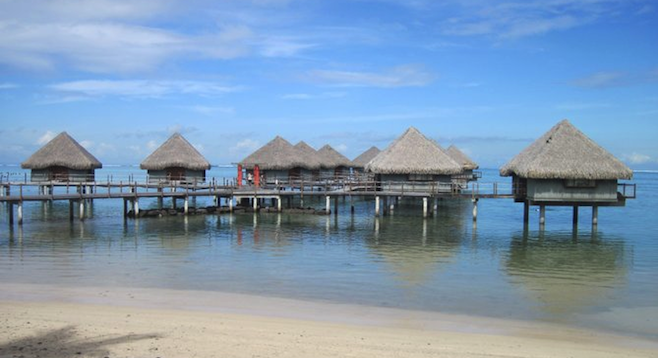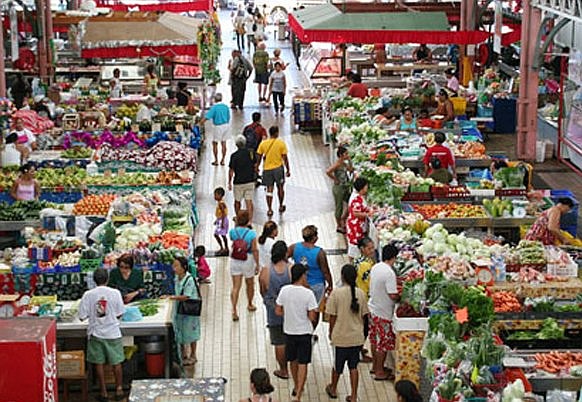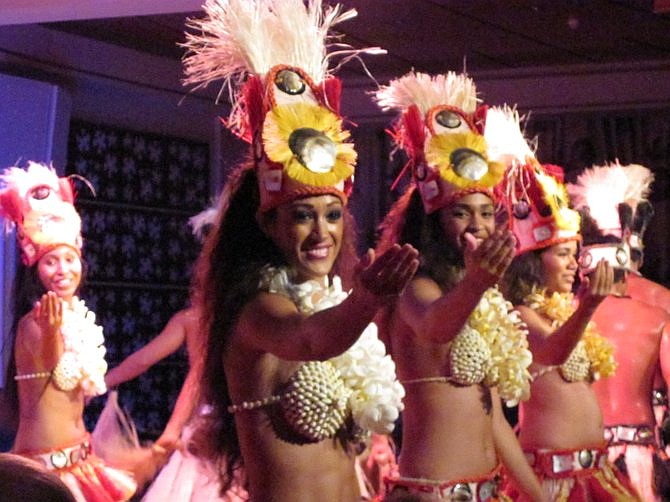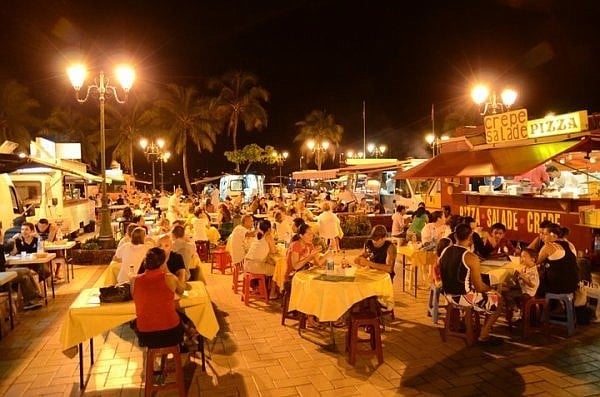 Facebook
Facebook
 X
X
 Instagram
Instagram
 TikTok
TikTok
 Youtube
Youtube

Papeete is the capital city of Tahiti, in French Polynesia. Relatively easy to reach from the West Coast, it's an eight-hour nonstop flight from LAX.
Upon arrival at Tahiti's Faaa Airport, we were greeted by Tahitian vahines (women) who gave the traditional tiare flower to place behind our ears: left ear if you're taken, right ear if you're available (or behind both if you're undecided). Also present in the arrivals area were Tahitian musicians and a dancer, creating a welcome respite from the hustle and bustle we left behind in L.A.
Papeete is a modern, cosmopolitan city with a blend of South Pacific and European influences. Being a French territory, sidewalk cafes, upscale boutiques, pearl shops, and fine French cuisine are common.

Papeete's picturesque waterfront is home to its cultural centers, cruise ship piers, and ferry docks to its sister Island Moorea. Just a few blocks form the pier is Papeete's colorful two-story open air public market, Le Marché , where locals and visitors come to shop. Here you'll find everything from fresh seafood and produce to local handicrafts, clothing and souvenirs. It's best to visit in the early morning when it is bustling with activity.
We opted to stay just outside of Papeete at the Le Meridien, which has a nice little beach and sand bottom swimming pool. We splurged for one of the overwater bungalows (top), perched over the lagoon with crystal-clear waters and a stunning view of Moorea. From our outdoor deck we could feed the tropical fish teeming over the coral reef just outside of our bungalow. It was idyllic, and the soothing sound of the waves crashing on the outer reef made for a good night's sleep.

We did venture out to the main restaurant and bar where an amazing Polynesian drum and dance troupe was performing for the guests. The speed and agility of the beautiful Tahitian women as they gyrated their hips to the pulsating beats was incredible to watch.
Once the sun sets, downtown Papeete really comes to life. One of the best features is the roulottes, or food trucks, that set up every night at the waterfront promenade. Between 10 and 20 food trucks offer everything from Chinese food to crepes, pizzas, poisson cru (the Tahiti national dish – raw tuna in coconut milk) and a variety of other specialties. In addition to being a great place to mix with locals, it also offers a great value for dinner, as most nice restaurants in Tahiti can be quite pricey. As the night wears on into the late hours, Papeete's denizens of the night can be found hanging in and around vibrant nightclubs and bars.

Papeete is the only part of French Polynesia to have any nightlife, and it is not unusual to see local entertainment in the form of drag queen shows and other colorful characters.
We rented a car to explore the main island outside the city, and it was well worth doing. The circle island road passes some stunning black sand beaches, historical landmarks related to Captain Cook and the crew of the Bounty, natural blowholes, majestic waterfalls and small roadside eateries.
We ventured further out to Tahiti Iti ( the smaller part of the island), all the way to the road's end at the famous surf spot Teahupoo. Unfortunately the waves were flat, but we enjoyed the beach for awhile and the beautiful scenery in that undeveloped part of the island.


Papeete is the capital city of Tahiti, in French Polynesia. Relatively easy to reach from the West Coast, it's an eight-hour nonstop flight from LAX.
Upon arrival at Tahiti's Faaa Airport, we were greeted by Tahitian vahines (women) who gave the traditional tiare flower to place behind our ears: left ear if you're taken, right ear if you're available (or behind both if you're undecided). Also present in the arrivals area were Tahitian musicians and a dancer, creating a welcome respite from the hustle and bustle we left behind in L.A.
Papeete is a modern, cosmopolitan city with a blend of South Pacific and European influences. Being a French territory, sidewalk cafes, upscale boutiques, pearl shops, and fine French cuisine are common.

Papeete's picturesque waterfront is home to its cultural centers, cruise ship piers, and ferry docks to its sister Island Moorea. Just a few blocks form the pier is Papeete's colorful two-story open air public market, Le Marché , where locals and visitors come to shop. Here you'll find everything from fresh seafood and produce to local handicrafts, clothing and souvenirs. It's best to visit in the early morning when it is bustling with activity.
We opted to stay just outside of Papeete at the Le Meridien, which has a nice little beach and sand bottom swimming pool. We splurged for one of the overwater bungalows (top), perched over the lagoon with crystal-clear waters and a stunning view of Moorea. From our outdoor deck we could feed the tropical fish teeming over the coral reef just outside of our bungalow. It was idyllic, and the soothing sound of the waves crashing on the outer reef made for a good night's sleep.

We did venture out to the main restaurant and bar where an amazing Polynesian drum and dance troupe was performing for the guests. The speed and agility of the beautiful Tahitian women as they gyrated their hips to the pulsating beats was incredible to watch.
Once the sun sets, downtown Papeete really comes to life. One of the best features is the roulottes, or food trucks, that set up every night at the waterfront promenade. Between 10 and 20 food trucks offer everything from Chinese food to crepes, pizzas, poisson cru (the Tahiti national dish – raw tuna in coconut milk) and a variety of other specialties. In addition to being a great place to mix with locals, it also offers a great value for dinner, as most nice restaurants in Tahiti can be quite pricey. As the night wears on into the late hours, Papeete's denizens of the night can be found hanging in and around vibrant nightclubs and bars.

Papeete is the only part of French Polynesia to have any nightlife, and it is not unusual to see local entertainment in the form of drag queen shows and other colorful characters.
We rented a car to explore the main island outside the city, and it was well worth doing. The circle island road passes some stunning black sand beaches, historical landmarks related to Captain Cook and the crew of the Bounty, natural blowholes, majestic waterfalls and small roadside eateries.
We ventured further out to Tahiti Iti ( the smaller part of the island), all the way to the road's end at the famous surf spot Teahupoo. Unfortunately the waves were flat, but we enjoyed the beach for awhile and the beautiful scenery in that undeveloped part of the island.
Comments